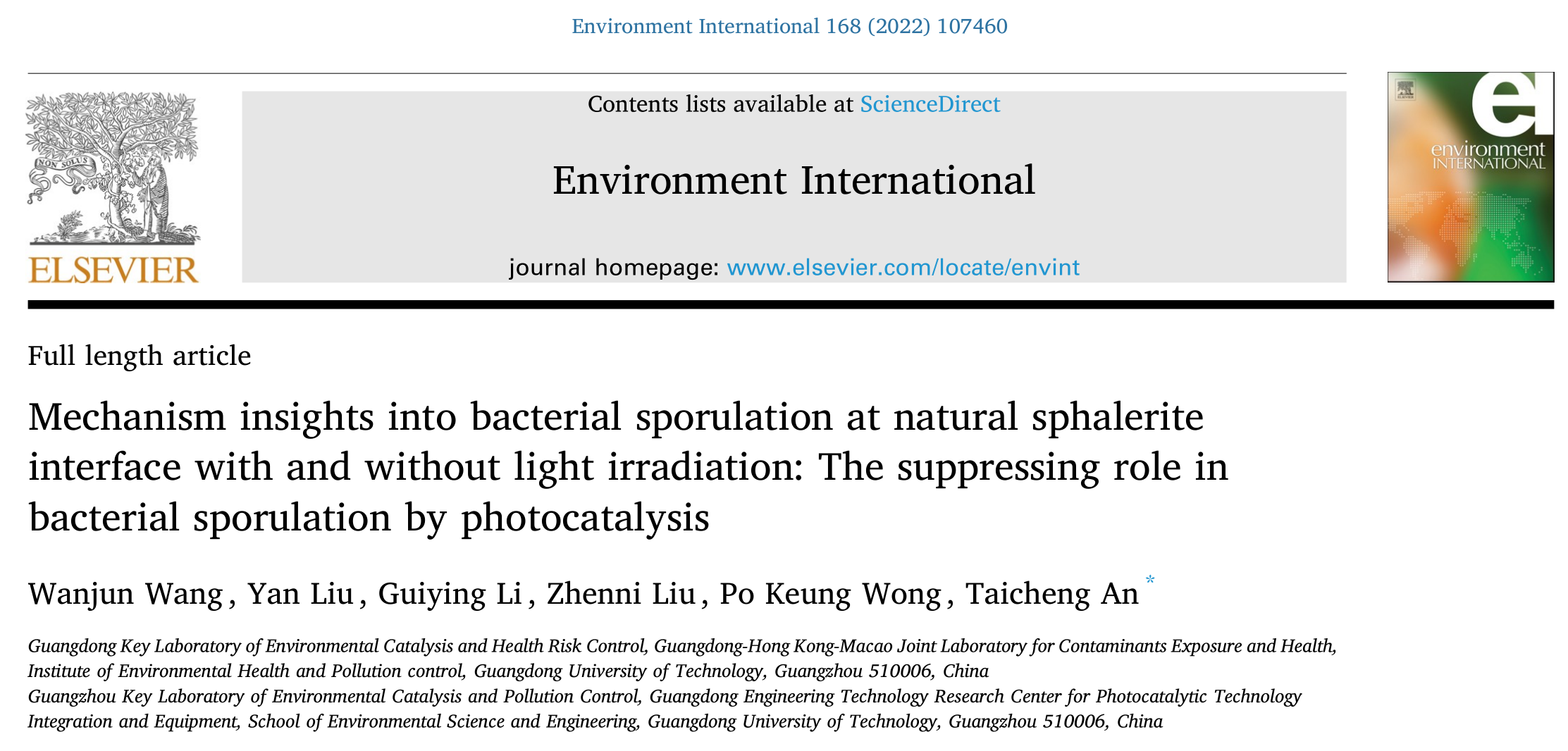近日,广东工业大学环境健康与污染控制研究院、环境科学与工程学院安太成教授团队题为《Mechanism insights into bacterial sporulation at natural sphalerite interface with and without light irradiation: The suppressing role in bacterial sporulation by photocatalysis》的学术论文在Environment International (2022, 168, 107460)杂志上发表。论文第一作者为王万军教授,第二作者为刘艳硕士生,通讯作者为安太成教授。该工作首次开展了产芽孢菌在天然矿物界面形成孢子及其光催化抑制产孢机制的研究,实验发现天然矿物在黑暗条件下可促进产芽孢细菌形成内生孢子,而在光照条件下利用其光催化作用可抑制孢子的形成,并详细探讨了细菌产孢机理及光催化灭活机制,提出了针对水体消毒过程中细菌芽孢演化与灭活的新策略。

论文DOI:https://doi.org/10.1016/j.envint.2022.107460
论文网址:https://www.sciencedirect.com/science/article/pii/S0160412022003877?via%3Dihub
图文摘要:

细菌芽孢作为水生环境中的一类高抗性微生物存在形式,阐明其在光和矿物界面的形成与演化机制,不仅有利于充分理解自然界矿物/微生物相互作用机制,而且可以有针对性地开发细菌芽孢的灭活与阻控技术。本研究以枯草芽孢杆菌(B. subtilis)和天然闪锌矿(NS)为例,首次系统研究了矿物界面上产芽孢菌分别在黑暗和光照条件下的产孢机制。在黑暗条件下,实验发现NS可使B. subtilis的营养细胞失活,促进其产孢率。这可能是NS在水环境中释放的Zn2+导致了营养细胞失活和芽孢的形成。在光照情况下,NS的光催化产生的活性氧物种显著提高了B. subtilis的灭活效率,使其产孢效率则从8.1%下降到4.5%,表明光催化作用可在一定程度上抑制芽孢的形成。进一步研究发现光生H2O2和•O2-是其提高其产芽孢菌灭活效率和抑制其产孢过程中起主要作用的活性氧物种。同时发现在黑暗条件下,NS促进了作为芽孢形成生物标志物的二吡啶甲酸(DPA)的细胞内合成,而在光照下NS的光催化作用则抑制了DPA的合成,进而抑制了芽孢形成。通过3D-EEM和SEM监测了B. subtilis从营养细胞到细菌芽孢的转化过程,并探讨了其转化过程中的细胞应激响应机制,实验发现与单独NS相比,光+NS界面诱导了胞内ROSs水平提升更高,抗氧化酶活性上调,细胞代谢活性降低,最终导致营养细胞灭活率提高,从而抑制了细菌芽孢的形成。该成果深入探讨了细菌芽孢在光和矿物界面的形成和演化机制,不仅可以揭示细菌产孢作为NS界面亚致死光催化应激反应的一种新模式,而且可以为水消毒过程中通过光催化抑制产孢效应来控制产孢细菌提供了一种新的策略。
论文的英文摘要附如下:
ABSTRACT
Unveiling the mechanisms of bacterial sporulation at natural mineral interfaces is crucial to fully understand the interactions of mineral with microorganism in aquatic environment. In this study, the bacterial sporulation mechanisms ofBacillus subtilis(B. subtilis) at natural sphalerite (NS) interface with and without light irradiation were systematically investigated for the first time. Under dark condition, NS was found to inactivate vegetative cells ofB. subtilisand promote their sporulation simultaneously. The released Zn2+from NS was mainly responsible for the bacterial inactivation and sporulation. With light irradiation, the photocatalytic effect from NS could increase the bacterial inactivation efficiency, while the bacterial sporulation efficiency was decreased from 8.1% to 4.5%. The photo-generated H2O2and •O2-played the major roles in enhancing bacterial inactivation and suppressing bacterial sporulation process. The intracellular synthesis of dipicolinic acid (DPA) as biomarker for sporulation was promoted by NS in dark, which was suppressed by the photocatalytic effect of NS with light irradiation. The transformation process from vegetative cells to spores was monitored by both 3D-fluerecence EEM and SEM observations. Compared with the NS alone system, the NS/light combined system induced higher level of intracellular ROSs, up-regulated antioxidant enzyme activity and decreased cell metabolism activity, which eventually led to enhanced inactivation of vegetative cells and suppressed bacterial sporulation. These results not only provide in-depth understanding about bacterial sporulation as a new mode of sub-lethal stress response at NS interface, but also shed lights on putting forward suitable strategies for controlling spore-producing bacteria by suppressing their sporulation during water disinfection.